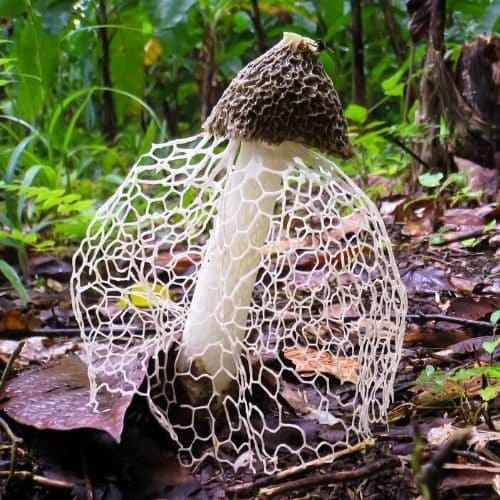
When she wakes up, bathing in sweat, she still feels slightly better as her nanomachines have scrounged some minerals and other volatiles from the environment, and the Moiety Alien is still there, waiting for her. They travel onwards, to the temperate zone and the tropics. A straight line from pole to pole is about ninety-eight kilometers, so she could get to the other side in two days walking if nothing untoward happens. She hasn’t replenished enough for her metamaterials to develop a sufficient wingspan for flying-cum-hang-gliding. Walking is restful and gives her a completely different perspective.
Reminiscing about her new environment, Na-Yeli has a few sobering thoughts. She gathers that if the animals in the polar zone are already much bigger than their Earth equivalents, then the animals in the temperate zone—and especially the tropics—might be even bigger.
These massive animals, this megafauna is just too big to fight, Na-Yeli realizes, we have to avoid a confrontation. She programs the metamaterials to alter the appearance of her exoskin depending on its surroundings—which it can monitor through the myriad of mini-cameras that Na-Yeli carries. Like a cuttlefish in a coral reef, or more appropriately like a chameleon in a tropical forest, Na-Yeli blends with her environment, tries to become one with it.
While adjusting her camouflage, she shines her torch at the Moiety Alien and nods fervently. It can change the color of its orbitals but always keeps one orbital in one color. She doesn’t know if it can change color on small sections of its orbitals. Yet she needs to find out.
The Moiety Alien moves up and down quickly in response, then comes to rest as its orbitals begin flickering, changing colors so fast its eight orbitals become one big blur. Then the blurring stops and they display quickly changing random patterns of black and white spots, like a cathode-ray tube of pre-interstellar travel times tuned to no channel at all. The blacks and whites become colors, the random changes become more orderly, and eventually, a camouflage pattern mimicking Na-Yeli’s appears on the Moiety Alien’s orbitals. Very good, Na-Yeli nods fervently, holding two thumbs up, excellent.
Blending with their environment as much as possible, Na-Yeli and the Moiety Alien travel onwards, straight north. Past the permafrost into the temperate region that starts quite barren and mostly mossy. Then the first signs of shrubs and trees—gargantuan ones, of course—and flocks of big birds crossing the sky. A large herd of grazers—a woolly crossover between horses and goats—feed on the tall grasses of the open meadows. They either don’t notice Na-Yeli and the Moiety Alien or simply ignore them. No sign of predators, which is probably for the best.
Na-Yeli is strangely attracted to this layer. It’s very Earth-like, yet when she looks close the differences become apparent and create a compelling cognitive dissonance—the moment she thinks she recognizes something, it’s something else indeed. She’d love to study this strange version of home much longer, and in much more depth, but duty beckons. Oh well, maybe on the way back ...
The subtropical zone resembles a savannah with huge thorn bushes and impossibly tall trees near well-attended watering holes. The animals they see are similarly oversized—ultra-giraffes with impossibly long necks, a cross between a triceratops and a hippo with very thick legs she dubs Stomposaur, inflated elephants she mentally calls Zeppelinfants and four-meter long reptiles, not unlike Komodo dragons, whose huge farts are combustible, she amusedly calls Reverse Dragons.

But the megafauna is not that easily fooled. Except for sight, there’s also sound—they are listening for them, and Na-Yeli does make a sound as she moves—and there’s no smell—they’re sniffing the air. While Na-Yeli’s exoskin can isolate her from any environment, so she does not leave a smell, the megafauna then tries to listen for something that does move, but does not leave a smell (they’ve probably been there before, with other aliens).
As such, Na-Yeli—and supposedly the Moiety Alien, even if it floats silently through the air—need to be extra careful. It slows down their progress considerably, yet Na-Yeli suspects her footage will be worth its proverbial weight in gold, in these times meaning worth its terabytes in longevity elixir. Progressing slowly, carefully, they try to avoid the megafauna, which is easier said than done, as they move surprisingly silently. Their large feet in combination with the low gravity most certainly a factor in this.
They’re getting ever deeper in the subtropics, where savannah and dense rainforests are interspersed. Clouds do form and rain does fall in this weird ecosystem, and not unlike Earth, some places are wetter than others. Na-Yeli and the Moiety Alien cross the edge of a rainforest that’s still wet from the latest rain, evidenced by the gathered raindrops on huge, green leaves, as the occasional drip, drip of rainwater still falling from the trees, and the moist smell of fresh precipitation permeates it all.
Even if these dense rainforests are harder to cross, Na-Yeli sometimes wants to get off the savannah where—despite their camouflage—she still feels exposed. On the other hand, it’s also easier for them to run into a local animal, but Na-Yeli rationalizes it by the assumption that it’s mostly prey that’ll be camouflaged like them, not predators. And she likes the change of scenery.
Initially, nothing strange seems to happen in this stretch of rainforest. Still, she has this uncanny feeling of a presence, of something that’s there that she is not seeing. Or better, that she’s overlooking, something that’s so normal she ignores it, something that’s hiding in plain sight. It’s irritating, like an itch you can’t scratch, but Na-Yeli just ignores it, as there are bigger dangers lurking.
Then the Moiety Alien starts to hum. That is, Na-Yeli hears a humming sound and scans every inch of the rainforest within sight, looking for, but not quite finding it. Frustrated, she wants to shrug it off and casts a questioning look to the Moiety Alien. Only then does she see that her alien friend is vibrating quickly, all eight orbitals of it and that this vibration is the source of the hum she’s hearing.
Not much is known about Moiety Aliens, and nowhere in her database is a record of them vibrating and producing a buzzing sound. She tries to draw its attention, using several gestures that worked fine before, but it does not react. In the meantime it keeps vibrating, not quite enough to make Na-Yeli worry about its health—not more than she already is, anyway—but enough to render its camouflage useless.
She gestures to her friend to stop the shaking, but—if anything—its trembling increases as its humming rises in tone. Even more noise and less camouflage, Na-Yeli thinks, as if it wants to be found. Or—the more devious part of her offers—as if whatever phenomenon that’s causing this, wants us to be found by the megafauna.
She tries everything to get through to her alien friend, even touching it—which she never even considered before—but all to no avail. The Moiety Alien’s shaking increases further, and its humming becomes both louder and more shrill. If this goes on, even a snoring Stomposaur will hear it a mile away.
She’s really worried now, not only about the Moiety Alien’s condition but also afraid that some of the megafauna will burst upon the scene soon. Can she somehow tow her friend away? She starts preparing a makeshift rope and looks for the nearest exit as she suddenly sees it. There’s too much white in this rainforest, she thinks, what gives?
Where she previously ignored the occurrence of mycelium filaments at the bottom of the odd leaf, she now sees it sprouting everywhere: between branches, covering trunks, stretching over bushes. Neither did the odd mushroom or toadstool worry her much. But now there are toadstools, boletuses, and mushrooms, of all shapes and kinds, everywhere: puffballs and chanterelles popping up through the undergrowth—how did Na-Yeli get here without squashing any?—turkey tails on trunks, artist’s fungus covering thick boughs, too many to mention.
What’s this mycelium infestation, this mushroom invasion, Na-Yeli thinks, El Fungi? Somehow the Moiety Alien is under its spell, while she remains unaffected. These are not fungi occupying their ecological niche, but a veritable fungal take-over. Na-Yeli hasn’t seen this many mushrooms since the single time she tried psilocybin tea. Countless white spores saturate the air as the myriad of mycelium filaments seems to envelop them like a cocoon. In the meantime, the Moiety Alien’s vibrating like mad, producing a high-pitched whirr that would drown out your average helicopter.
This is getting out of hand, she has to do something, anything. How to fight this madness? The Moiety Alien isn’t paying any attention to her frantic signaling. How to get it out of its fugue? Pull it away? Or ... fight fire with fire?
She gets her most powerful floodlight and flashes it at maximum intensity at her alien friend. Again. And again. Is she imagining it, or is the pitch of its whirring lowering? She programs the floodlight to flash in stroboscopic pattern, first with well-established hypnotic patterns, then with their antitheses. It works, as the Moiety Alien’s vibrations visibly lessen and its frantic noise dies down to a low hum. To finish off this madness, she slaps one of the Moiety Alien’s orbitals, never thinking she would ever have to do that. To her utter relief, it returns to normal.
Then, all of a sudden, the overabundance of spores, mycelia, molds, and yeast-like infestations and all kinds of toadstools, mushrooms, and other fungi disappear. Also, as if by a miracle, no megafauna has noticed their weird—and often loud—behavior. Their camouflage is working again, and the amount of fungi in the environment seems normal.
Somehow, it reminds Na-Yeli of unconfirmed rumors of a solar system whose two habitable planets were dominated by an intelligent, planet-spanning network of fungi, which would annihilate anything resembling a mammal, irrespective if these mammals evolved there naturally or landed there in their space ships. Even in the space age, rumors, myths, and legends remain.
Then the Moiety Alien moves to and from her, its movement signals suggesting that it is worried about her. In her relief, Na-Yeli shakes it off as a side effect of its fugue. ‘No problem,’ she tries to gesture, pointing at herself, ‘I’m OK’—two thumbs up—‘but are you?’—pointing at the Moiety Alien, then wiggling her hands. It doesn’t seem to remember its strange episode, at all.
But no time to reminisce about that, as they were just making such good headway. And they should now be paying attention to their surroundings, not to themselves. Na-Yeli shrugs—something the Moiety Alien has already picked up—and gestures that they should move on.
—or—
Author’s note: from the icy North Pole and the frigid tundra to the temperate zone and the sub-tropics, where megafauna roams. Yet sometimes one has to pay attention to the flora—or the life that grows upon it—as well. Spoiler alert: the El Funghi section is a homage to Jeff VanderMeer (and Area X from Annihilation in particular).
Anyway, this is a warm-up (foreshadowing in writer-speak) of the real action, which will start in the next part. A special welcome to new subscribers and many thanks for reading!





